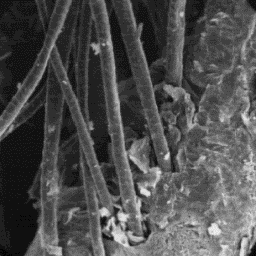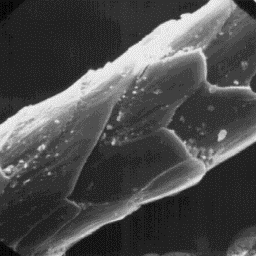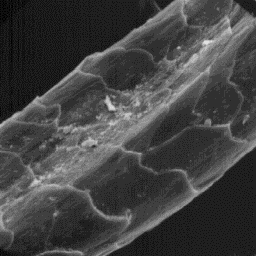 Ovis aries - Semi-Persian lamb skin
Ovis aries - Semi-Persian lamb skin
-----------------------------------
English: Sheep
German: Hausschaf
French: Mouton
Spanish: Ovejas
The sheep is one of the oldest domes-
ticated animals and, today, many varieties
are bred in all the inhabited continents.
The species can be classified into three
groups according to the wool quality: the
fine wool type, the semi-fine wool type and
the coarse wool type. Zoologically, the
sheep could be classified into four groups.
In the first group are the fatty-tailed The surface structure
sheep, yielding high quality Persian furs, of the skin, 200x
for example Kara-kul, Balcanian, Moldavian,
Bagdad type and others. In the second group are the wide- backed sheep, with
semi-Persian wool, for example, the Astrakhan, Tibetian, Indian, Pakistan and
Afghanistan breeds. The third group covers the short-tailed breeds with coarse
wool. These sheep are the older and, today industrially less important types
and, for fur purposes, only lamb skins are used. The last group are the
thin-tailed sheep, with a fine wool coat, which are the most important in the
wool industry. The main representatives of this group are the merino species
and similar fine wool-coated types.
|
|
 Ovis aries - Semi-Persian lamb skin
Ovis aries - Semi-Persian lamb skin
-----------------------------------
English: Sheep
German: Hausschaf
French: Mouton
Spanish: Ovejas
Distribution areas
------------------
The semi-Persian fur types come from the
lamb skin of the wide-backed sheep of which
the Afghan species is a typical example.
Description of the fur
----------------------
The skins are from 25 to 70 cm long and The cuticular structure
about 15 to 40 cm wide. The coat is of the fine fibres, 2000x
dark-brown or black in colour; some
varieties are grey. The thickness of the coat is from 8 to 20 mm. The fibres
are rolled into whirls but the tips are often visible and not turned in
towards the coat as in the case of Persian lamb skin.
|
|
 Ovis aries - Semi-Persian lamb skin
Ovis aries - Semi-Persian lamb skin
-----------------------------------
English: Sheep
German: Hausschaf
French: Mouton
Spanish: Ovejas
Structure of the hair
---------------------
The microscopic structure of the skin
surface is furrowed and the hair follicles
are narrow with straight edges. The average
follicle contains only one hair shaft.
The fine fur fibres are circular in
cross-section and have a diameter of 8 to The cuticular structure
12 µm. The cuticular scales are cornet-like of an intermediate hair, 1000x
with smooth surfaces and straight scale
margins. These fine fibres are non-medullated.
|
|
 Ovis aries - Semi-Persian lamb skin
Ovis aries - Semi-Persian lamb skin
-----------------------------------
English: Sheep
German: Hausschaf
French: Mouton
Spanish: Ovejas
The intermediate fibres are circular or
ellipsoidal in cross-section with a
diameter of 15 to 30 µm. The cuticular
scales are cornet-like and, in the coarser
fibres, even tile-like with a smooth scale
surface and straight scale margins. These
fibres are usually non-medullated.
The guard hairs, which are, in fact, the Longitudinal section
longest and coarsest fibres, are very of a guard hair, 600x
similar to the intermediate fibres and have
a diameter of 40 to 60 µm. The cuticular scales are even tile-like with a
smooth surface and straight scale margins. Some scales have a non-regular
grooved surface. The medullar column is narrow, unbroken and central
symmetrical-shaped in cross-sectional outline. The medullar structure belongs
to the non-regular type with a fibrous or amorphous infilling material.
|
|
 Ovis aries - Semi-Persian lamb skin
Ovis aries - Semi-Persian lamb skin
-----------------------------------
English: Sheep
German: Hausschaf
French: Mouton
Spanish: Ovejas
Longitudinal section
of an intermediate fibre, 1000x
Numerical code for semi-Persian lamb skin structure
---------------------------------------------------
Surface of the skin: 3-4-1
Fine fur fibres: 1-5-1-1-4-0-0-0-0-8.12-6.25
Intermediate fibres: 2.1-5.2-1-1-4-0-0-0-0-15.31-20.45
Guard hairs: 2-2-1.3-1-3-1-1-16-7.8-40.61-25.21
|




